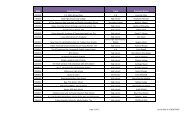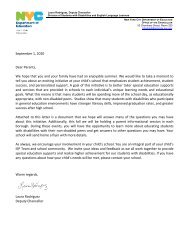Predicting language outcome in infants with autism and pervasive ...
Predicting language outcome in infants with autism and pervasive ...
Predicting language outcome in infants with autism and pervasive ...
Create successful ePaper yourself
Turn your PDF publications into a flip-book with our unique Google optimized e-Paper software.
<strong>Predict<strong>in</strong>g</strong> <strong>language</strong> <strong>outcome</strong> <strong>in</strong> <strong>in</strong>fants <strong>with</strong> <strong>autism</strong> 281predicted improvement <strong>in</strong> expressive (but not receptive) <strong>language</strong> skills. The currentf<strong>in</strong>d<strong>in</strong>gs are also consistent <strong>with</strong> those of Stone <strong>and</strong> colleagues who found alongitud<strong>in</strong>al association between imitation <strong>and</strong> jo<strong>in</strong>t attention <strong>and</strong> later expressive<strong>language</strong> ability (Stone et al. 1997, Stone <strong>and</strong> Yoder 2001). Stone <strong>and</strong> Yoder alsofound that play was longitud<strong>in</strong>ally associated expressive <strong>language</strong>, aga<strong>in</strong> not replicated<strong>in</strong> the present study. Stone et al. also demonstrated specificity <strong>in</strong> the longitud<strong>in</strong>alassociations between imitation abilities <strong>and</strong> later <strong>language</strong> ability <strong>in</strong> that imitationof body movements but not actions on objects was associated <strong>with</strong> later expressive<strong>language</strong> skills. We had <strong>in</strong>tended to <strong>in</strong>clude imitation of a series of gestures (Charman<strong>and</strong> Baron-Cohen 1994) as well as actions on objects. However, the first fewparticipants tested could not be sufficiently engaged <strong>in</strong> a face-to-face imitativesituation (or at least were not socially <strong>in</strong>terested enough to watch the adult or torespond) <strong>and</strong> this measure was dropped from the study.The present study has several limitations that limit the <strong>in</strong>terpretation of thef<strong>in</strong>d<strong>in</strong>gs. One is the restricted sample size that <strong>in</strong>creases the risk of type II errors.Another is the relatively undifferentiated level at which some of the socialcommunicativebehaviours were measured. For example, an ord<strong>in</strong>al (0-1-2) cod<strong>in</strong>gwas used to measure the presence/absence of any functional or pretend play acts<strong>in</strong> the spontaneous play session. In addition to the difficulties <strong>with</strong> measur<strong>in</strong>ggestural imitation mentioned above, other more differentiated aspects of the socialcommunicativemeasures that warrant attention <strong>in</strong> future studies <strong>in</strong>clude thesequence of responses to <strong>and</strong> <strong>in</strong>itiation of jo<strong>in</strong>t attention acts as measured by theESCS (Seibert et al. 1982, Mundy et al. 1990, Sigman <strong>and</strong> Rusk<strong>in</strong> 1999), <strong>and</strong> cod<strong>in</strong>gof affect dur<strong>in</strong>g such <strong>in</strong>teractions (Kasari et al. 1990). As already <strong>in</strong>dicated, the veryyoung age <strong>and</strong> difficulty of <strong>in</strong>teract<strong>in</strong>g <strong>with</strong> the children <strong>with</strong> <strong>autism</strong> <strong>and</strong> PDDforced some of these restrictions upon us. For example, we did code po<strong>in</strong>ts towardsthe activated toy <strong>and</strong> vocalizations <strong>in</strong> the jo<strong>in</strong>t attention tasks but <strong>in</strong> the <strong>autism</strong><strong>and</strong> PDD participants these behaviours occurred so rarely as to be unanalysable(Charman et al. 1997, 1998). We also coded doll <strong>and</strong> non-doll related play separately,but aga<strong>in</strong> the rarity of these behaviours amongst the present sample meant wecould only analyse data at the less differentiated level. Another limitation was thelong <strong>in</strong>terval between data collection po<strong>in</strong>ts. Consequently, associations that mayhave held over one period (e.g. from 20 to 30 months) will have been missed.Future studies should follow children from <strong>in</strong>fancy <strong>in</strong>to the preschool years atshorter <strong>in</strong>tervals. Another limitation was that we had no formal measure of <strong>language</strong>at 20 months. Although the Reynell-DLS was attempted <strong>with</strong> each participant atthis age, nearly all the sample fell below this basal at age equivalent of 12 months.This reflects a more general difficulty of us<strong>in</strong>g formal <strong>language</strong> assessments <strong>with</strong>children <strong>with</strong> <strong>autism</strong> spectrum disorders at a young age (Charman et al. 2003). Thereis also some circularity to this issue as very early communication behaviours assessedby many <strong>language</strong> schedules <strong>in</strong>clude jo<strong>in</strong>t attention <strong>and</strong> imitation behaviours similar<strong>in</strong> k<strong>in</strong>d to the experimental tasks of social-communication <strong>in</strong>cluded <strong>in</strong> the currentstudy.On the positive side, prospective identification of <strong>in</strong>fants <strong>with</strong> <strong>autism</strong> <strong>and</strong> PDDus<strong>in</strong>g the CHAT screen enabled us to study the associations between early socialcommunicativeability <strong>and</strong> later <strong>language</strong> ability at a younger age than has previouslybeen accomplished. Other recent work has identified social-communicative impairments<strong>in</strong> children <strong>with</strong> <strong>autism</strong> <strong>in</strong> skills that emerge <strong>in</strong> typical development earlierthan those studied here, e.g. <strong>in</strong> social orient<strong>in</strong>g (Dawson et al. 1998, Baranek 1999).




